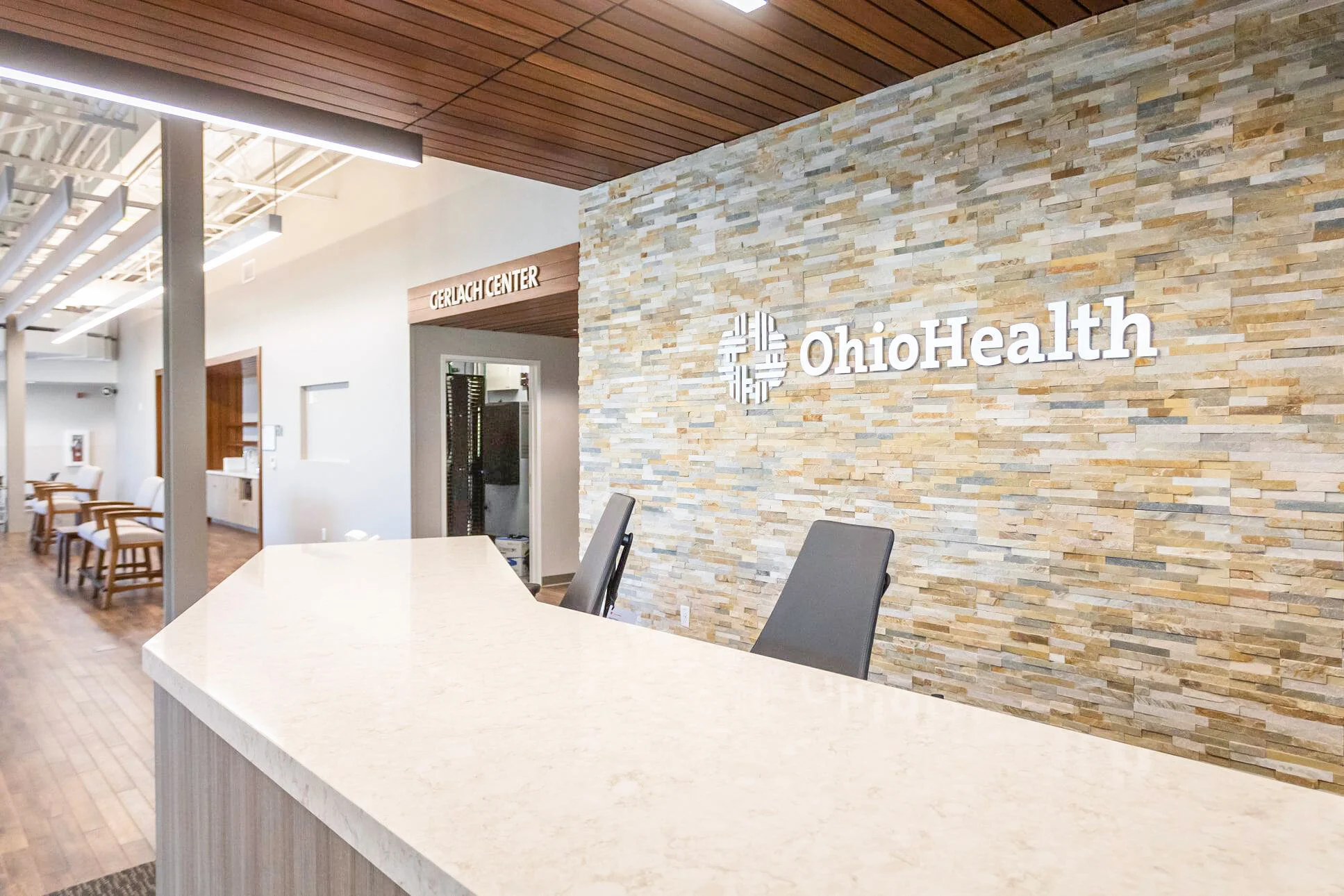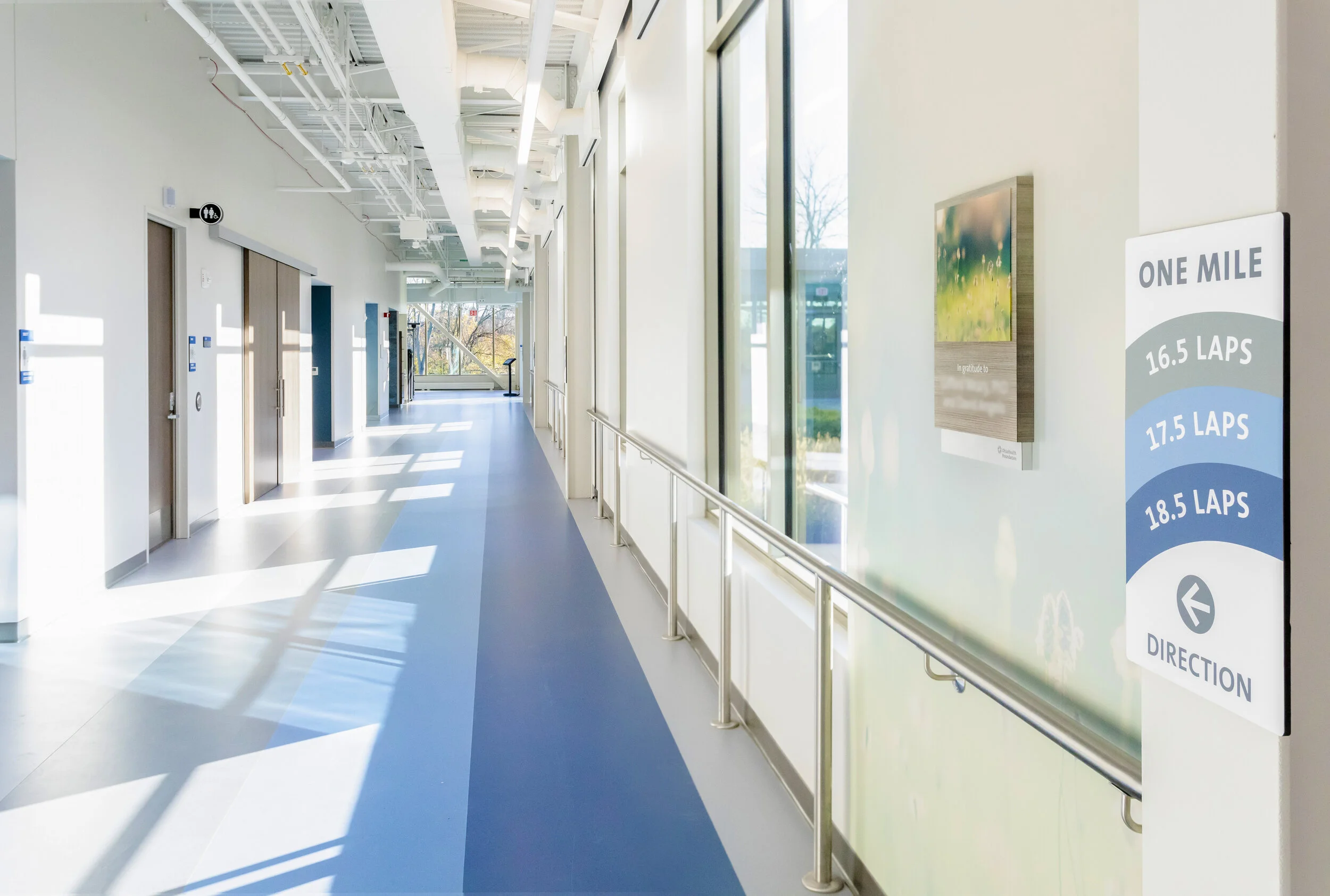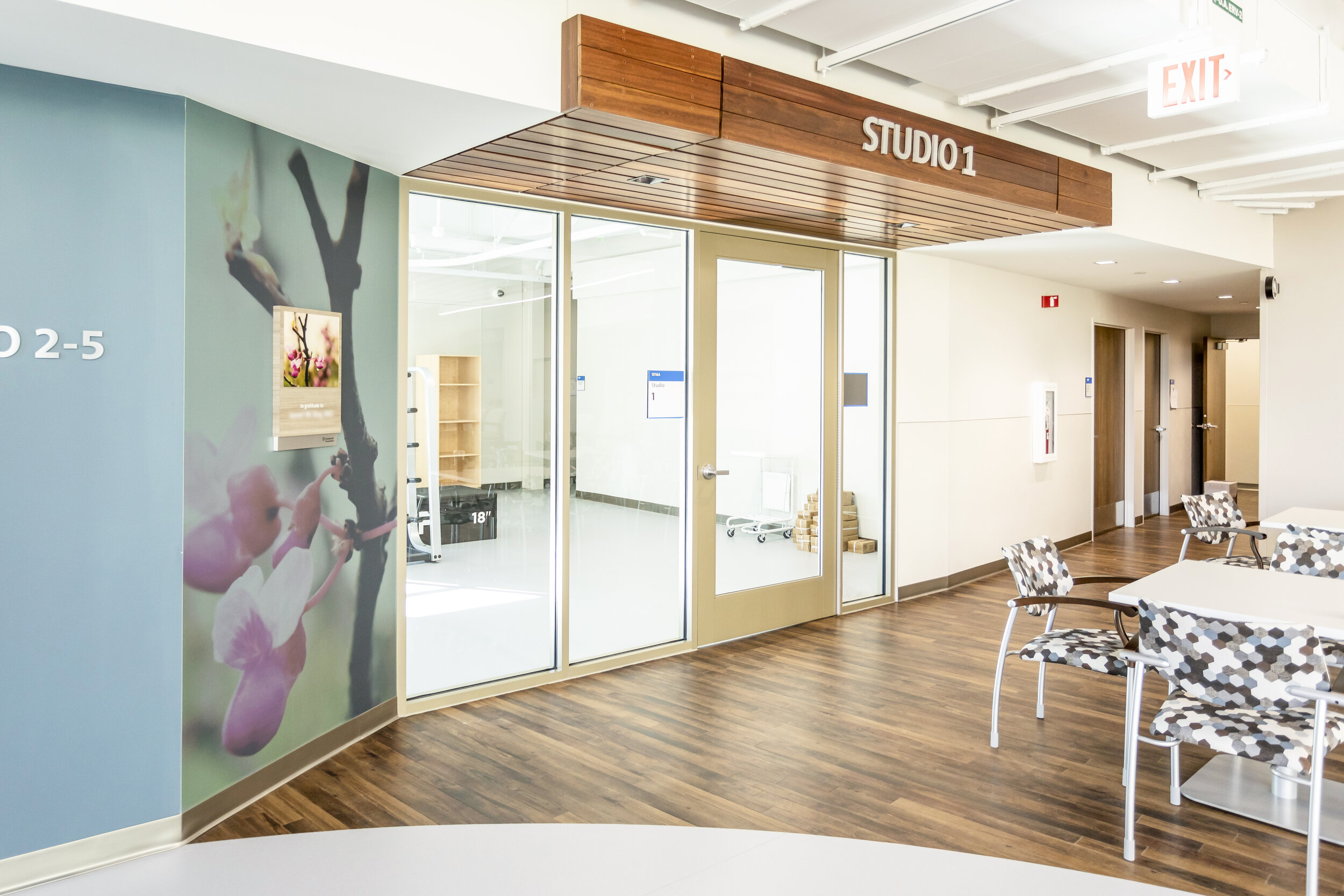Have you ever walked into a space and felt completely immersed in your surroundings? And you’re not just swept away when you get there — even when you leave, you know that you’ll remember your experience.
These memorable spaces are known as branded environments, and they’re a fantastic way to bring your organization to the next level.
Branding your organization’s space can help you make a positive first impression with visitors, motivate your staff, and help connect supporters to your mission. Why? Because your cause will surround anyone who enters your facility, serving as a reminder of the value of your work.
At Eleven Fifty Seven, we’re passionate about elevating organizations to their greatest potential, and that includes transforming their spaces. In this guide, we’ll dive into branded environments to give you a comprehensive understanding of what they are and what they can do for your organization. We’ll cover:
For any organization, a branded environment goes beyond a donor wall or an interesting logo. Branding your space is about creating an experience for visitors that will help them connect with your cause. By creating a space that deeply resonates with visitors, you can motivate them to volunteer, donate, or spread the word about your mission. Let’s take a closer look at how branded environments can revolutionize your space!
branded Environments: Frequently Asked Question
Before taking a look at some examples of branded environments, let’s review some of the essentials so that everyone is on the same page.
What is a Branded environment?
A branded environment is a space that an organization designs to reflect its mission, values, and aesthetic. This space essentially takes your brand, brings it to life, and invites visitors to step inside.
Branded environments utilize a variety of creative elements, including images, text, architecture, and technology to transform an ordinary space into a reflection of your organization’s mission.
Your organization’s brand is crucial for building donor relationships and establishing yourself within the sector. A recognizable brand will be more trustworthy to supporters and forge a tighter association between it and your cause.
For example, through effective branding, the World Wildlife Fund has become synonymous with its panda logo and with environmental conservation. A branded environment is one way to begin building this recognizability and trustworthiness.
Where can I find a branded environment?
You can find a branded environment practically anywhere, but the immersiveness can vary from location to location. For instance, while a theme park might be a highly branded experience, an airport might take a subtler approach. Either way, both of these environments include branded elements as a part of their spaces.
Most organizations typically have some branded elements within their facilities on displays such as entrances or areas that focus on donor recognition. However, many organizations have the potential to elevate their branded environments to create a more immersive experience.
What are the benefits of a branded environment?
Did you know that you only have 7 seconds to make a good first impression? A captivating branded environment ensures that you start off in the right way.
Branding your organization’s environment is a great way to make your mission easily understandable to anyone who visits your facility, whether they are already familiar with your organization or are just getting started.
But there are other benefits besides great first impressions. With a branded environment, you can:
Design a memorable experience: Give your visitors an unforgettable experience by completely immersing them in your organization’s mission. They will walk away with a thorough understanding of the importance of your cause and the value of your work.
Create a productive environment for staff: Your staff joined your organization because they care about your cause. Remind them of the significance of their work with a branded environment.
Stand out from the crowd: By capturing your brand’s essence within your space, you can show supporters your professionalism and dedication to your cause. Plus, you can engage and educate anyone who walks through your door while you’re at it.
Transforming your facility into a branded environment creates a better experience for everyone. After all, you want to inspire anyone who pays your organization a visit to help you forward the social good, so why not begin with your space?
examples of branded environments by Eleven Fifty Seven
Now that you have a grasp of the fundamentals of branded environments, let’s dive into some examples.
east texas food bank
The East Texas Food Bank completely transformed its space, turning what was a typical facility into a branded environment. Using its color scheme, typography, and unique design features, visitors to the food bank immediately get a sense of this nonprofit’s impactful work.
This branded environment is also enhanced by educational features, such as the statistics shown here, and the emotional appeal created by the photo of the children.
The branded environment continues with this timeline and floor decals throughout the space, which showcase the journey of donated food through the facility. By using the same style elements, this display maintains a cohesive and immersive experience for visitors.
OhioHealth Foundation
The OhioHealth Foundation also branded its space to better reflect its mission to keep its members healthy through preventative medicine and overall wellness. The light colors and natural woods create a welcoming environment for visitors, members, and staff alike. Additionally, the curved spaces make the facility easy to navigate for visitors of all abilities and neurological abilities.
To create an experiential design that members could interact with, the OhioHealth foundation transformed its hallway into a track for members to run or walk on. Not only does this feature offer additional resources to members, but it also serves as a reminder of wellness and exercise.
The open space and bright natural light create a subtle yet inspiring environment to promote exercise and wellness. The flower imagery is peaceful, which is particularly beneficial for mindfulness practices such as yoga and meditation.
On the wall, the OhioHealth Foundation also thanks its donors with a wooden plaque that fits with the overall theme of the facility.
Campbellsville University
With its hall of fame style, this Campbellsville University conference room promotes the talent and hard work of its athletes and coaches. By using school colors, this display establishes a sense of pride around its sports teams. The large logo and motto also create an image that visitors will certainly not forget!
Other Examples of Branded Environments
Feeding america
Feeding America’s headquarters features this display to highlight the nonprofit’s mission. The plant elements recognize the agricultural elements of Feeding America’s mission. The color scheme aligns with the organization’s brand, which creates an immersive experience for visitors. Lastly, the text serves as a reminder of Feeding America’s fantastic achievements.
TED
The TED headquarters in New York reflect the organization’s mission with conference-style seating, which promotes open conversation and the spreading of ideas. Staff members will likely feel as though they can participate freely because of the inviting aspects of this environment.
The open floor plan continues in this lobby area, which allows for more conversation between guests and staff. The bright colors are visually interesting and the lines along the ceiling also create the impression of several ideas flowing together.
charity:water
Like the TED headquarters, the charity:water headquarters features a very open space to generate conversation and make it easy for staff and visitors to interact. The photos along the wall also reflect charity:water’s mission to provide clean and safe water.
charity:water also includes a unique water feature, which flows through the center of the office. This element serves as a reminder of charity:water’s mission, and shows visitors the power of clean water for all.
4 Steps to design a branded environment
After seeing these examples, you might be wondering how you can create a branded environment of your own. Look no further! We’ve created a step-by-step checklist that you can use to design a branded environment for your organization.
1. establish the purpose of your branded environment.
Your first step should be asking yourself why you want a branded environment. Do you want to educate your visitors? Thank previous donors? Motivate your staff? Encourage supporters to donate? It’s perfectly fine if you have multiple goals, but narrowing down your purpose to something specific can help you design your space with the most precision.
The purpose you land on will shape the entire tone of your branded environment. For example, if your primary goal is educational, you might want to incorporate several infographics or digital interactive elements. However, if you want to focus on your staff, you might opt for a conversation-driven and collaborative space.
If you’re struggling to narrow down your purpose, try asking yourself: what should a visitor to my facility get out of their experience? Use your answer as a jumping off point to get into the deeper purpose of your branded environment.
2. brainstorm different ideas.
Once you’ve established your main purpose, it’s time to brainstorm different ways to achieve it. There are two main categories that you should focus on while you’re brainstorming: purpose and style elements.
You already feel passionate about your branded environment’s purpose, so you want to get it right. When coming up with ideas to achieve your purpose, you should consider:
The emotions visitors should feel.
The ways in which the display will reflect your brand.
The content you will include.
In order to capture your purpose, you’ll need to use intriguing and aesthetically pleasing style elements. These elements could include:
Color palette.
Typography.
Construction methods.
Interactive elements.
By combining the purpose-driven elements and the style elements, you can determine a cohesive design that aligns with your brand and your goals. When you’re brainstorming, be sure to write down all of your ideas, even if you don’t think they’d be feasible at first. This way, when you move to the next step, you have lots of options to choose from.
An experienced design firm like Eleven Fifty Seven can help you identify these elements and navigate the process of aligning them with your mission.
3. Design the specifics
After brainstorming comes the decision-making phase. With several ideas at your fingertips, you now have to decide which selections are the right ones for your organization. To make your selections, try asking yourself the following questions:
What idea resonated with you the most?
Is it eye-catching and memorable?
Will it reflect your brand accurately?
What do your team members think? Your other supporters?
Each of these questions can help you determine which purpose-driven elements and which style elements are best for your organization. And, as you’re designing your specifics, don’t forget to tie everything back to your original purpose.
4. Build your branded environment.
The final step to creating a branded environment is to build it! The installation phase can have its frustrations, between ensuring that everything goes according to plan, working around the construction, and staying organized. However, just remember that installation takes time, and if you’ve adequately prepared, you should have nothing to worry about!
Once your branded environment is complete, consider hosting an unveiling party to show your supporters and staff the fruits of everyone’s hard work. Use this opportunity to connect with everyone who helped your organization get to this point.
Wrapping Up
When visitors come to your facility, you want to create an experience that they won’t soon forget. With a branded environment, you can immerse visitors in your organization’s mission to create a lasting connection.
An impactful branded environment should balance aesthetics with content. Be sure that your mission lies at the center of your design so that anyone can appreciate your organization’s hard work.
Want to learn more about how branding can transform your organization? Check out these additional resources:
Nonprofit Branding: Crash Course & Strategy Checklist: Why is nonprofit branding important for any type of organization? This crash course can show you all the benefits of nonprofit branding.
Experiential Design: Complete Crash Course & Examples: What does it mean for a space to create an experience? This article on experiential design can help you design a space like no other.
Donor Recognition: Complete Strategy Guide & 13 Ideas: How should you recognize your generous donors? Here are thirteen ideas to get you started!



















